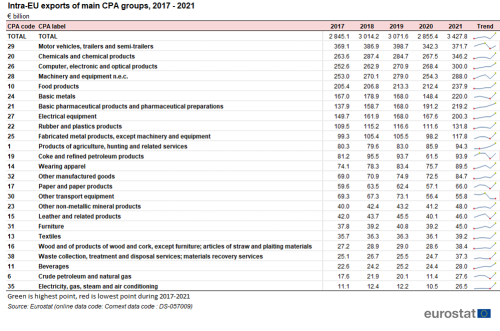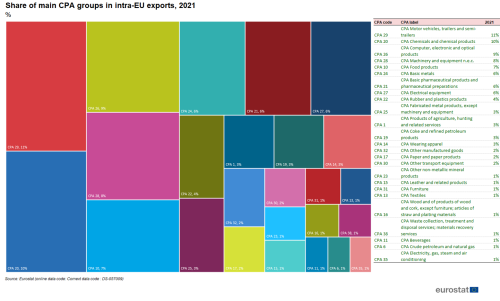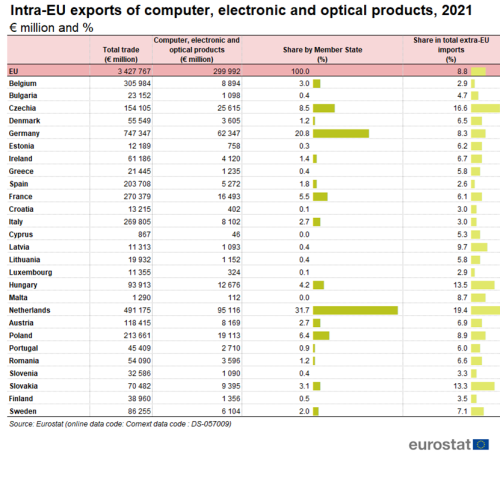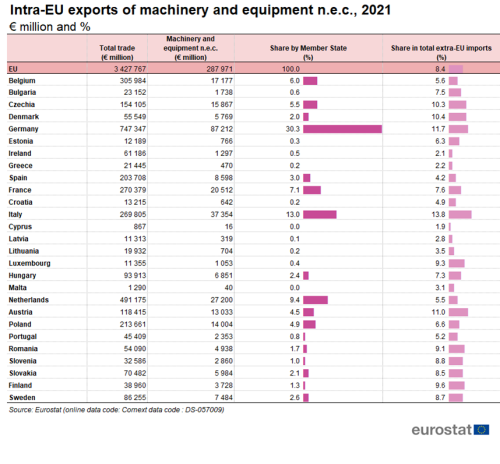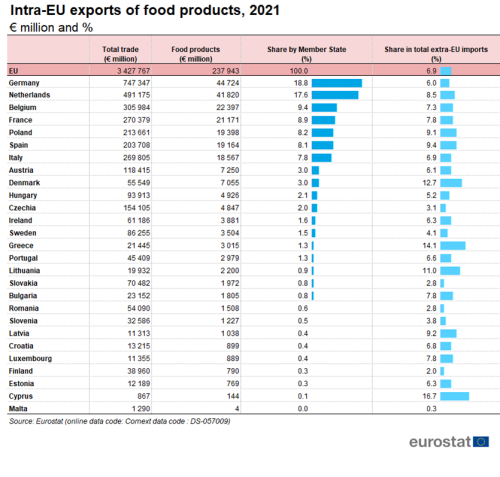Archive:Intra-EU - most traded goods
This Statistics Explained article has been archived - for recent articles on International trade in goods see here.
Data extracted in April 2022.
Planned update: April 2023.
Highlights
Between 2017 and 2021, the 5 most exported types of goods between EU countries were motor vehicles, trailers and semi-trailers, chemicals and chemical products, computer, electronic and optical products, machinery and equipment n.e.c. and food products.
Between 2017 and 2021, exports between EU countries increased by €583 billion, despite falling by €216 billion in 2020 due to the Covid-19 pandemic.
Top 5 CPA categories in intra-EU exports, 2017 - 2021
This article focuses on the most significant goods by value (according to the CPA classification) in intra-EU exports and presents statistics for the EU from 2017 to 2021. Statistics on goods traded between the EU and the world — especially the size and evolution of exports — enable the EU and national authorities to evaluate the health and competitiveness of EU industries. The article discusses the contribution of individual Member States to total intra-EU exports for the five most exported product groups. Additionally, it shows the share these product groups have in each Member State's total intra-EU exports of goods.
This article is part of an online publication providing recent statistics on international trade in goods, covering information on the EU's main partners, main products traded, specific characteristics of trade as well as background information.
Full article
Evolution of intra-EU trade
The CPA classification consists of 40 products. Table 1 shows the 24 most exported products, while the remaining 16 are grouped as "other". Among the 24 products, 23 recorded an increase in exports in 2021. The exceptions was other transport equipment (CPA 30) which decreased by €0.6 billion.
The composition of total exports of goods in 2021 in the 24 CPA groups mentioned in Table 1, is presented in Figure 1. The top five product groups are Motor vehicles, trailers and semi-trailers (cars), Chemicals and chemical products (chemicals), Computer, electronic and optical products (computers), Machinery and equipment n.e.c. (machines) and Food products (food). The rest of this article will concentrate on these top five products. Together they account for 45 % of all exports. Cars (11 %) and chemicals are the only product with a share above 10 %.
The 5 most significant products in intra-EU trade
The most exported product within the EU was cars. Its exports increased from €369 billion in 2017 to €372 billion in 2021 (see Figure 2) despite a decrease of €56 billion in 2020. The intra-EU exports of the second to fifth most traded products all grew in this period, most notably for chemicals whose exports increased from €264 billion in 2017 to €346 billion in 2021
Intra-EU trade of the most traded goods by Member State
The analysis in this section looks at intra-EU exports by individual EU Member State for the five most traded products identified above. Tables 2 to 6 show the shares of these products in total exports, showing how important these products were in each Member State. The detailed data underlying these figures can be found in the excel file attached to this article.
In 2021, Germany was the largest exporter of cars in the EU. Its exports of €90 billion were 24.1 % of total EU exports to other Member States (Table 2). There were three Member States where the share of cars in their total exports within the EU was above 20 %. These were Slovakia (29.0 %), Slovenia (20.6 %) and Romania (20.2 %).
In 2021, Germany was the largest exporter of chemicals in the EU. Its exports of € 73 billion were 21.1 % of total EU exports to other Member States (Table 3). There were six Member States where the share of chemicals in their total exports within the EU was above 10 %. These were Ireland (21.9 %), Belgium (18.9 %), France, Lithuania (both 13.3 %), the Netherlands (12.4 %) and Estonia (11.4 %).
In 2021, the Netherlands was the largest exporter of computers in the EU. Its exports of € 95 billion were 31.7 % of total EU exports to other Member States (Table 4). There were four Member States where the share of computers in their total exports within the EU was above 10 %. These were the Netherlands (19.4 %), Czechia (16.6 %), Hungary (13.5 %) and Slovakia (13.3 %).
In 2021, Germany was the largest exporter of machines in the EU. Its exports of €87 billion were 30.3 % of total EU exports to other Member States (Table 5). There were five Member States where the share of machines in their total exports within the EU was above 10 %. These were Italy (13.8 %), Germany (11.7 %), Austria (11.0 %), Denmark (10.4 %) and Czechia (10.3 %).
In 2021, Germany was the largest exporter of food in the EU. Its exports of € 45 billion were 18.8 % of total EU exports to other EU Member States (Table 6). There were four Member States where the share of food in their total exports within the EU was above 10 %.These were Cyprus (16.7 %), Greece (14.1 %), Denmark (12.7 %) and Lithuania (11.0 %).
Source data for tables and graphs
Data sources
EU data comes from Eurostat’s COMEXT database.
COMEXT is the Eurostat reference database for international trade in goods. It provides access not only to both recent and historical data from the EU Member States but also to statistics of a significant number of non-EU countries. International trade aggregated and detailed statistics disseminated from Eurostat website are compiled from COMEXT data according to a monthly process. Because COMEXT is updated on a daily basis, data published on the website may differ from data stored in COMEXT in case of recent revisions.
Information on intra-EU trade is collected by the EU Member States using the various media placed at the disposal of the information providers. These may be paper or electronic declarations provided for at national level. The declarations are addressed directly to the competent national administrations.
European statistics on international trade in goods are compiled according to the EU concepts and definitions and may, therefore, differ from national data published by Member States.
Product classification
Classification of products by activity (CPA) is a statistical classification of products and services obligatory for all EU Member States. CPA classifies products by activity in which they are produced. Products are transportable goods and services. The CPA is a product classification whose elements are related to activities as defined by NACE Rev. 2. Each product - whether it be a transportable or a non-transportable good or a service - is assigned to one single NACE Rev. 2 activity. The linkage to activities as defined by NACE Rev. 2 gives the CPA a structure parallel to that of NACE Rev. 2 at all levels distinguished by NACE Rev. 2.
Unit of measure
Trade values are expressed in billions (109) or millions (106) of euros. They correspond to the statistical value, i.e. to the amount which would be invoiced in case of sale or purchase at the national border of the reporting country. It is called a FOB value (free on board) for exports and a CIF value (cost, insurance, freight) for imports.
Comparability across countries
Intra-EU statistics of EU Member States are comparable across countries since:
- European statistics are drawn up on the basis of a broadly common methodology and common definitions;
- the problem of the FOB and CIF valuations generally plays a smaller role in view of the geographical context and the structure of intra-EU trade;
- given the rules for determining reference periods, time delays should not have such a large impact — at least on annual results;
- the trade partner for intra-EU imports is always the EU Member State of consignment, not the country of origin of the goods.
Dutch trade flows are over-estimated because of the so-called ‘Rotterdam effect’ (or quasi-transit trade): that is goods bound for other EU countries arrive in Dutch ports and, according to EU rules, are recorded as extra-EU imports by the Netherlands (the country where goods are released for free circulation). This in turn increases the intra-EU flows from the Netherlands to those Member States to which the goods are re-exported. To a lesser extent, Belgian figures are similarly overestimated.
Context
The European internal market, also referred to as the Single Market, allows people and businesses to move and trade freely across the 27-nation group. The cornerstones of the single market are the free movement of people, goods, services and capital, known collectively as the ‘four freedoms’, which are included in the EU Treaty. Articles 34 to 36 of the Treaty of the functioning of the EU prohibit quantitative restrictions on imports, exports or goods in transit and all similar restrictive measures between EU Member States. All measures capable of hindering directly or indirectly such imports are considered to be quantitative restrictions. Additionally because the 27 EU Member States share a single market and a single external border, they also have a single trade policy. Both in the World Trade Organization (WTO), where the rules of international trade are agreed and enforced, and with individual trade partners, EU Member States speak and negotiate collectively.
Direct access to
- International trade in goods - aggregated data (ext_go_agg)
- International trade in goods - detailed data (detail)
- International trade in goods statistics - background
- International trade in goods (ESMS metadata file — ext_go_agg_esms)
- User guide on European statistics on international trade in goods
- Regulation (EC) No 471/2009 of 6 May 2009 on Community statistics relating to external trade with non-member countries
- Summaries of EU Legislation: Extrastat: statistics relating to trade with non-EU countries
- Regulation (EU) No 92/2010 of 2 February 2010 implementing Regulation (EC) No 471/2009, as regards data exchange between customs authorities and national statistical authorities, compilation of statistics and quality assessment
- Regulation (EU) No 113/2010 of 9 February 2010 implementing Regulation (EC) No 471/2009 , as regards trade coverage, definition of the data, compilation of statistics on trade by business characteristics and by invoicing currency, and specific goods or movements.
